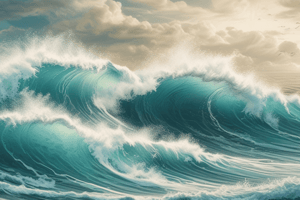Podcast
Questions and Answers
What factor influences the growth of waves by allowing the wind to transfer more energy to the water?
What factor influences the growth of waves by allowing the wind to transfer more energy to the water?
- Wind direction
- Wave duration (correct)
- Wave period
- Wave height
What can cause a wave to topple over into a white cap?
What can cause a wave to topple over into a white cap?
- Decreased wave period
- Reaching maximum wave height (correct)
- Reduced energy transfer
- Increased wind distance
Which type of waves are generated by severe weather like hurricanes?
Which type of waves are generated by severe weather like hurricanes?
- Seismic waves
- Storm surge waves (correct)
- Tsunamis
- Wind-driven waves
How does increasing the wave period affect the maximum wave height before toppling into a white cap?
How does increasing the wave period affect the maximum wave height before toppling into a white cap?
What causes hazardous waves like tsunamis apart from severe weather events?
What causes hazardous waves like tsunamis apart from severe weather events?
Flashcards are hidden until you start studying
Study Notes
Wind waves, also known as surface waves, are generated when wind blows across the surface of an ocean, lake, or river. The energy from the wind is transferred to the water and then to nearby water molecules, creating ripples and eventually larger waves. The formation of waves involves two primary processes: the transfer of energy from the wind to the water and the subsequent growth of the waves.
Wind Energy Transfer to Water
Wind energy is transferred to the water through two methods:
- Pressure changes: As the wind blows across the water, it creates small changes in air pressure that either push down on the ocean surface during high air pressure or lift up on the ocean surface during low air pressure.
- Shear forces: The wind also creates shear forces between the stationary water molecules and the moving air molecules, dragging the water molecules up and over the waves.
These forces cause small ripples or capillary waves on the water surface. As the wind continues to blow, these capillary waves grow larger and eventually develop into gravity waves, where they overcome the surface tension of the water and the controlling force becomes gravity, attempting to pull the now larger waves downwards.
Energy Transfer and Wave Growth
- Wind speed: The speed of the wind determines the size of the waves. The harder the wind blows, the larger the waves become.
- Duration of wind: The longer the wind blows, the larger the waves become as they absorb more energy from the wind.
- Fetch: The distance over which the wind blows also plays a role in wave growth. The greater the distance, the larger the waves become as the wind has more time to transfer its energy to the water.
Wave Height and Maximum Wave Size
Waves have a maximum theoretical height that depends on the wind speed, duration, and distance over which the wind blew. When a wave reaches its maximum height, it may topple over into what's called a white cap. Energy can still be added to the wave, but it will do so by increasing the wave energy below the surface, thus increasing the wave period. As the wave period increases, so does the maximum wave height before the wave topples into a white cap.
Types of Waves
Wind-driven waves, or surface waves, are the most common type of wave and are found globally across the open ocean and along the coast. More hazardous waves can be caused by severe weather, such as hurricanes, which generate long waves called storm surge. Other hazardous waves include earthquakes, landslides, or volcanic eruptions that displace large amounts of water quickly, creating waves called tsunamis.
Studying That Suits You
Use AI to generate personalized quizzes and flashcards to suit your learning preferences.




